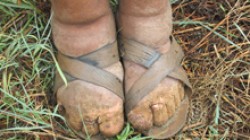Genetics of a Tropical Foot Disease
Genetics of a Tropical Foot Disease
Researchers have identified gene variants that boost the risk for a debilitating tropical disease called podoconiosis, which affects about 4 million people worldwide. The findings will help shed light on how interactions between genes and the environment influence susceptibility to disease.

Podoconiosis is a tropical disease that leads to painful swelling and eventual disfigurement of the feet. Photo by Dr. Fasil Ayele, NHGRI.
Podoconiosis, a type of elephantiasis, is a noninfectious disease that causes severe and painful swelling of the legs and feet. Also known as mossy foot disease, the condition can permanently disfigure the foot. It affects barefoot farmers who work on volcanic red clay soils in tropical areas. Doctors have long known that exposure to the soil can trigger the disease, and that it tends to run in families. Wearing shoes or even washing off the dirt can prevent the condition. But scientists have puzzled over why only some people develop the disease, while most working in the same environment are spared.
To learn more, an international team of scientists conducted a genome-wide association study (GWAS). The research was part of a trans-NIH effort led by NIH’s National Human Genome Research Institute (NHGRI). The investigators analyzed DNA from the saliva of nearly 400 volunteers, about half of whom had podoconiosis. All participants were from southern Ethiopia, where the disease affects about 1 in 20 people.
As reported in the March 29, 2012, New England Journal of Medicine, the scientists compared the genomes of people with and without the disease by screening for more than 550,000 single-nucleotide polymorphisms (SNPs). SNPs are sites in the genome where sequences differ by just a single chemical base. The researchers found that podoconiosis was significantly linked to 8 SNPs within or near to a stretch of DNA on chromosome 6, called the human leukocyte antigen (HLA) class II locus. HLA genes code for cell-surface molecules that play a key role in immune responses.
To confirm the finding, the researchers performed a family-based association study, examining DNA from 202 sets of trios. Each trio included an affected adult and both parents. The analysis detected 6 SNPs that were strongly linked to podoconiosis. These SNPs likewise mapped to the HLA class II region, validating the GWAS results.
The scientists next examined the HLA genes found in 94 affected people and 94 controls. The analysis confirmed that podoconiosis risk increases when certain variants of the HLA class II locus are inherited from one or both parents. Having these gene variants, the researchers estimate, makes it 2 to 3 times more likely that a person will develop podoconiosis if exposed to the volcanic rock soil.
Because the HLA class II locus is linked to T cell-mediated immunity, the researchers suggest that podoconiosis is likely a T cell-mediated inflammatory disease. When mineral particles in the soil are absorbed through the skin, they can build up in the lymph system of affected people. The resulting inflammation and scarring can block blood vessels in the feet.
“We found a result that is consistent with the clinical observations of inflammation and provides a way forward for scientific study of the disease,” says study co-author Dr. Adebowale Adeyemo of NHGRI. Further study of podoconiosis may also provide clues to how gene-environment interactions contribute to other complex genetic disorders.
“One aspect that makes podoconiosis disturbing is that it is almost 100% preventable by wearing shoes. So it is a disease of poverty to a very large extent,” says Dr. Charles Rotimi, director of the trans-NIH effort. Public health campaigns are now under way to encourage the use of footwear in affected areas.
###
* The above story is reprinted from materials provided by National Institutes of Health (NIH)
** The National Institutes of Health (NIH) , a part of the U.S. Department of Health and Human Services, is the nation’s medical research agency—making important discoveries that improve health and save lives. The National Institutes of Health is made up of 27 different components called Institutes and Centers. Each has its own specific research agenda. All but three of these components receive their funding directly from Congress, and administrate their own budgets.




















